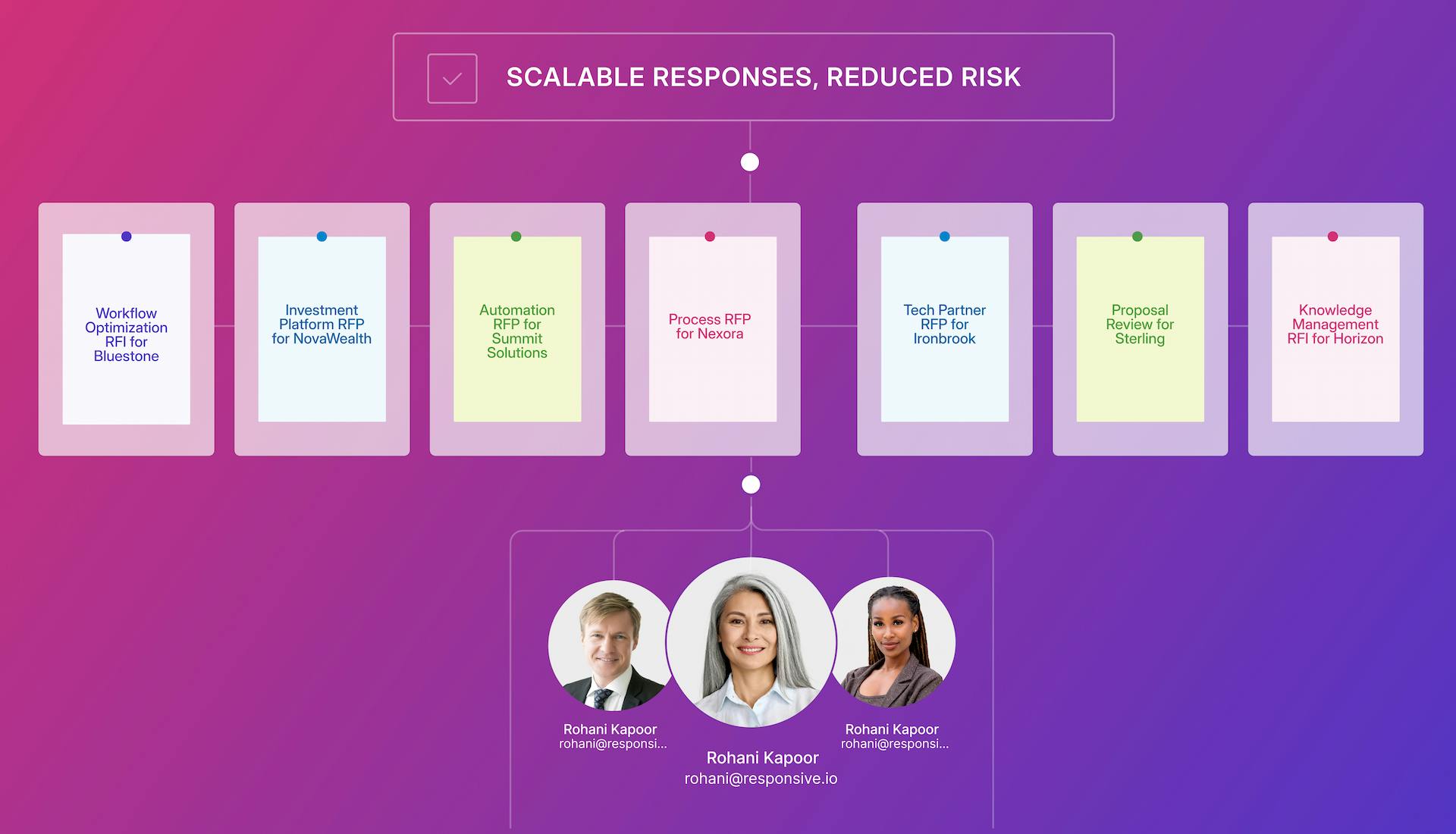Enterprise content management (ECM) is the discipline of organizing, governing, and distributing content at scale across a large organization. Today, teams must deliver accurate, compliant, and personalized content quickly while managing growing volumes of requests and increasingly complex approval processes.
Scattered repositories and outdated information remain significant barriers, slowing response cycles and undermining accuracy. As a result, ECM has become a frontline business requirement for enterprises competing on speed and consistency. The key challenge isn’t whether to prioritize ECM, but how to implement it effectively. Strong programs enable fast, defensible responses across proposals, questionnaires, and security assessments. In contrast, weak ones can do more harm than not having one at all by creating friction and eroding trust.
This guide explores the current state of ECM, the most pressing challenges, governance best practices, and the role of AI in all of it. It also shares examples from organizations like BlackRock and ADP that are demonstrating how effective ECM directly contributes to revenue growth.
The current state of enterprise content management
In the past, many enterprises treated ECM as a static archive: a place to store documents so they could be retrieved if necessary. That approach no longer works; it’s too slow and impossible to keep up with the current pace of organizations' operations. Today, ECM has evolved into active, democratized knowledge hubs where content is continually reviewed, refreshed, and made accessible across business units.
Scale magnifies both the opportunity and the complexity. Large enterprises manage thousands of content assets across multiple regions and business lines. Without a central framework, the risks multiply:
- Duplication: Teams recreate content that already exists.
- Inconsistency: Different groups rely on conflicting or outdated versions.
- Compliance exposure: Unchecked content increases the chance of errors reaching customers or regulators.
A well-governed content library addresses these issues by providing a single source of truth that reduces risk and accelerates accurate responses.
Another challenge lies in perception. According to the 2025 SRM Report:
- 78% of executives believe proposal and content teams are well supported.
- Only 43% of practitioners agree, highlighting a resource gap and disconnect between leadership and frontline teams.
This gap between executive perception and practitioner reality has real consequences. Some organizations, however, are finding ways to bridge it by reframing ECM as a revenue driver.
BlackRock is one such example. Kristen Carloni, Global Head of the Aladdin Business Proposal Strategy Team, shared that her team achieved a 746-to-1 ROI — delivering $746 in value for every dollar invested. By quantifying impact so clearly, the team shifted perceptions from cost center to revenue protector, building credibility and securing the executive sponsorship needed to scale effectively.
Common challenges with enterprise content management
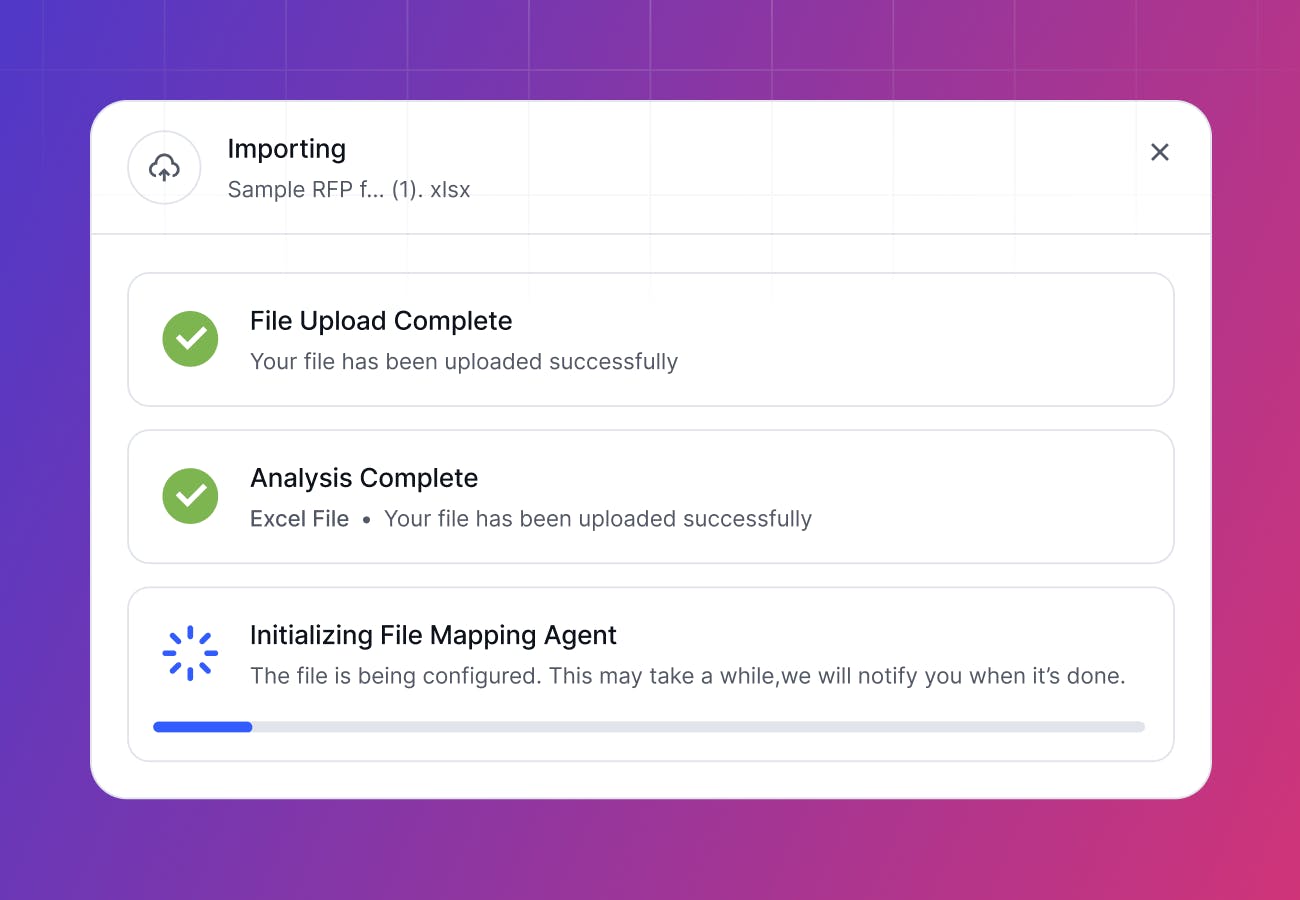
Even when ECM’s importance is recognized across the organization, execution can still fall short for any number of reasons:
- Content silos and duplication: Information often lives across departments and tools. Without a central library, teams duplicate efforts and risk sharing inconsistencies or outdated content.
- Lagging updates: Rapid changes in products, regulations, and client needs outpace manual review cycles, leaving even well-managed libraries vulnerable to outdated responses.
- Manual processes: Teams spend valuable time chasing subject matter experts, reformatting, and re-entering content. This is often done under deadline pressure and resource constraints.
- SME knowledge loss: When key experts depart, their context and expertise may disappear unless captured in a centralized library. This creates continuity risks and slows down the onboarding of new staff.
- Editorial inconsistencies: Multiple contributors editing content without oversight can erode tone, messaging, and clarity.
- Search inefficiency despite centralization: Even with a content library, poor tagging or bloated repositories make retrieval cumbersome, costing significant time to anyone dependent on using the library.
- Rising volume and complexity of requests: Modern RFx documents demand deeper cross-functional collaboration, making it difficult for teams to keep pace without automation.
- Strain on proposal teams: Despite being strategic revenue drivers, proposal teams often face rising volume and tight deadlines with limited recognition or resources.
Taken together, these challenges make it clear that ECM cannot be treated as a static repository; it requires active management and governance to deliver lasting value. Without this foundation, organizations risk inefficiency, compliance issues, and many missed opportunities.
Governance and risk management in enterprise content
Enterprises rarely operate within a single geography or function. Global teams span multiple time zones and regulatory environments, making consistency difficult to maintain. Cross-functional use adds another layer of complexity:
- Marketing, sales, compliance, and legal all rely on overlapping content.
- Teams often produce their own versions, creating duplication and inconsistency.
ECM addresses both challenges by centralizing ownership, allowing updates to flow across regions and departments, reducing duplication, and maintaining accuracy.
When connected to tools like Responsive Ask, ECM also improves how distributed employees access information:
- Natural-language search: Employees can type questions and instantly receive approved, cited answers.
- TRACE Score™ validation: Ensures responses are accurate and trustworthy.
- Reduced delays: Cuts down on time spent routing questions back to headquarters.
- Lighter SME workload: Decreases the burden on subject matter experts.
- Always-current access: Field teams, sales, and customer-facing staff get the latest compliant content — whether preparing proposals, responding to questionnaires, or addressing client inquiries in real time.
Best practices for enterprise content management
Establishing best practices is what turns ECM from a theoretical concept into a repeatable discipline that drives real results. By standardizing how content is managed, shared, and measured, enterprises create the consistency and confidence needed to respond quickly while reducing risk.
The following practices outline the building blocks that help ECM deliver lasting impact across the business:
- Formalize global governance frameworks: Assign clear ownership, establish review cadences, and define escalation paths to maintain consistency across regions and minimize compliance risk.
- Localize and translate content at scale: Adapt content to meet cultural and regulatory expectations in each market, ensuring that messaging resonates while avoiding costly errors.
- Segment access by business unit while enabling collaboration: Protect sensitive information through role-based permissions, while still allowing teams to share knowledge and work from the same foundation.
- Integrate ECM into enterprise-wide tech stacks: Connect content libraries with systems such as CRM, collaboration platforms, and proposal tools, allowing employees to access trusted information within their existing workflows.
- Measure ECM’s impact with executive-level KPIs: Track metrics such as cycle time, reuse rates, and accuracy scores to demonstrate business impact and justify continued investment.
- Invest in training and adoption programs: Provide structured onboarding, ongoing education, and user engagement initiatives to encourage consistent use of ECM across departments.
For a detailed walkthrough of specific practices such as centralizing content, enabling self-service, and using analytics to refine strategy, see our post on knowledge management best practices.
Integrations and scale
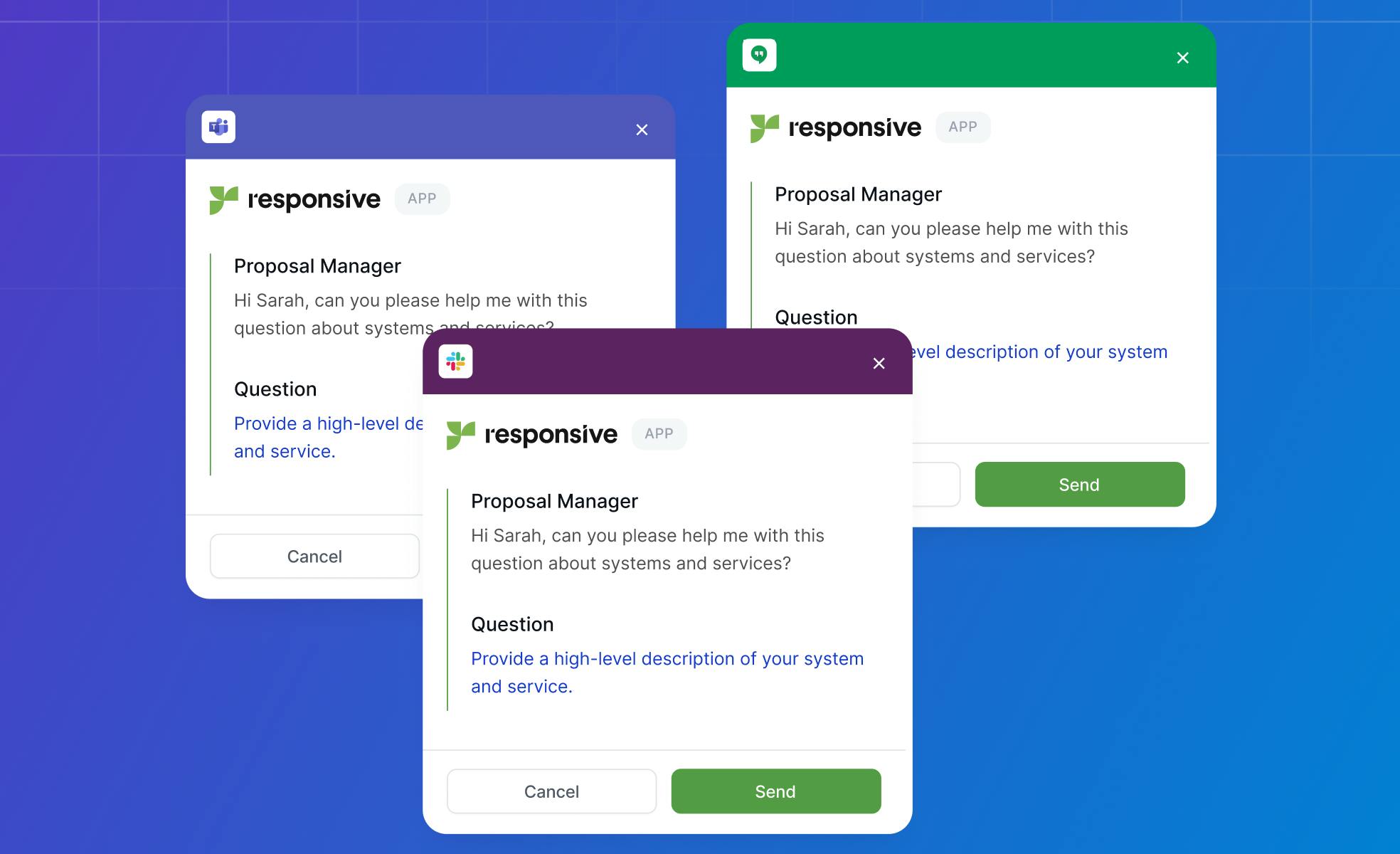
While governance may sit at the center of every enterprise-scale content management system, integration is what allows ECM to scale across the organization. By connecting content libraries with CRM platforms, collaboration tools, and proposal systems, organizations eliminate duplication and ensure consistent access to approved content.
Responsive LookUp illustrates this principle. Because many enterprises still manage RFPs in Excel or through browser-based portals, LookUp brings content directly into those environments. Instead of forcing employees to leave their workflow, the tool delivers approved answers quickly and in context.
The impact of integration isn’t theoretical. ADP demonstrates how embedding AI into response workflows reduces manual work and translates directly into higher win rates:
”We’ve been using AI to handle the setup work, and that’s taken about 30-40% off our proposal teams’ plates. That time is now spent engaging the buyer — following up, clarifying, customizing. And it’s working. We’ve seen a 7% lift in win rates since using AI this way, and we’re responding to more RFPs without adding headcount.”

Neel Shah
DVP of Commercial Operations ADP
Integrations also support enterprise-wide visibility. When ECM is connected to systems used by sales, compliance, and legal, leaders can see how content is applied across functions and which assets deliver the most impact. These insights highlight redundancies, uncover gaps, and inform content updates as well as broader go-to-market strategies.
In all of these ways, integrations turn ECM into a living system that adapts continuously to business needs while strengthening cross-functional collaboration.
Global and cross-functional considerations
Enterprises rarely operate within a single geography or function. Global teams span multiple time zones and regulatory environments, making consistency difficult to maintain. Cross-functional use adds another layer of complexity: marketing, sales, compliance, and legal all rely on overlapping content but often produce their own versions. ECM addresses both challenges by centralizing ownership, allowing updates to flow across regions and departments, reducing duplication, and maintaining accuracy.
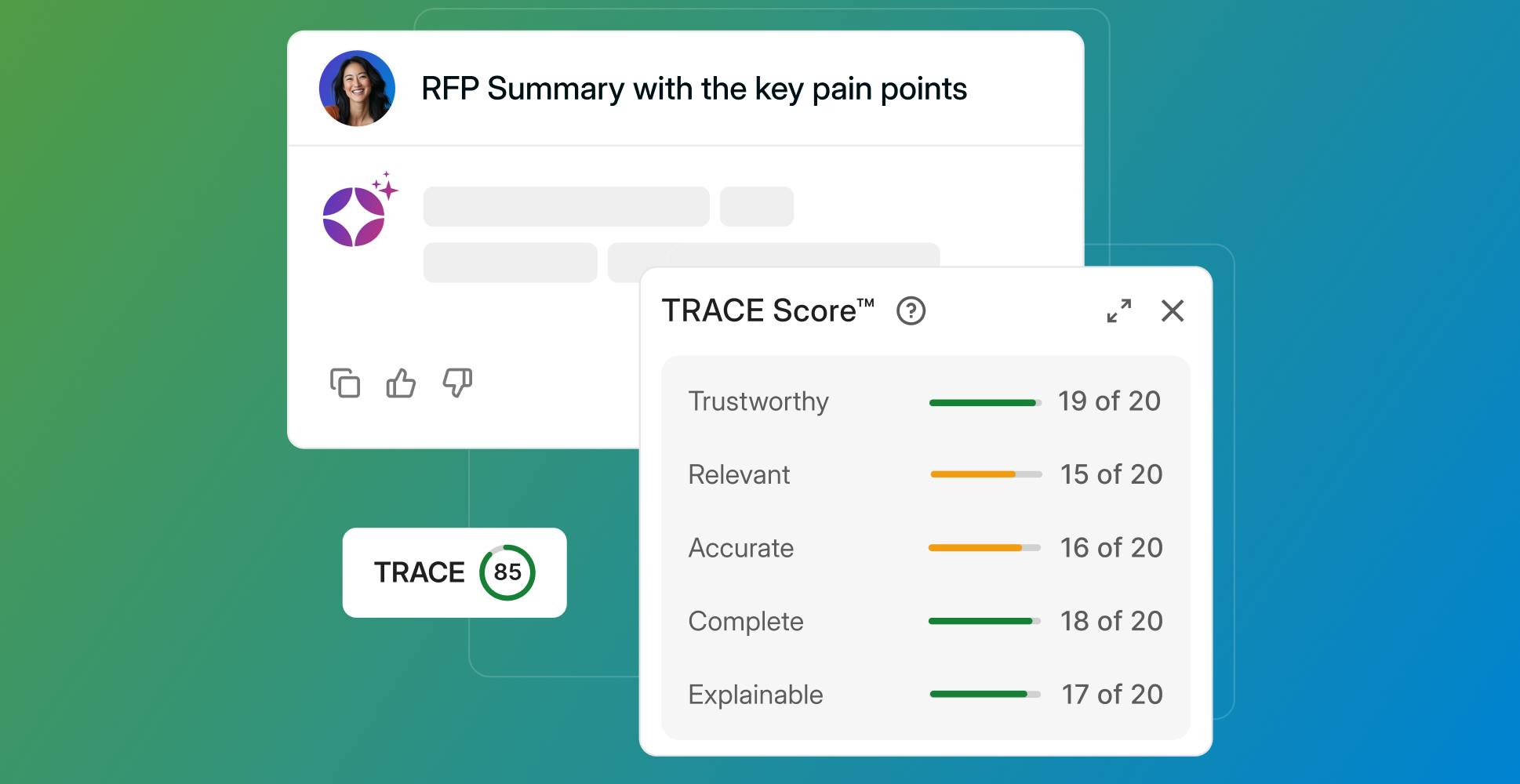
With ECM connected to tools like Responsive Ask, distributed employees can type natural-language questions and instantly receive approved, cited answers with TRACE Score™ validation. This eliminates delays that come from routing questions back to headquarters and lightens the load on subject matter experts. It also ensures that field representatives, sales teams, and customer-facing staff always have the latest compliant content at their fingertips — whether preparing proposals, responding to questionnaires, or addressing client inquiries in real time.
Measuring the impact of enterprise content management
Measuring the value of ECM calls for clear, consistent metrics. By grounding performance in data, everyone on the team can understand where ECM is working, where gaps remain, and how improvements translate into tangible results.
Quality and accuracy metrics
Because teams often struggle with outdated or incomplete content, which introduces business risk, leaders at top-performing enterprise-scale organizations are learning that structured governance and review cycles can address this by ensuring that every answer is accurate, validated, and defensible before reaching a customer.
To help highlight whether ECM is improving consistency and compliance, measure the following:
- Content audit frequency: Tracks how often content is reviewed and updated to ensure it remains accurate, compliant, and relevant.
- Error reduction: Captures the decrease in inaccuracies or compliance issues within responses after stronger governance and review processes are in place.
- TRACE Score averages: Measure the overall accuracy and trustworthiness of responses by assigning each answer a quality score.
Adoption and engagement metrics
As the 2025 SRM Report, executives often assume strong adoption, while practitioners cite ongoing gaps in resources and satisfaction. Tracking adoption helps surface where additional training, engagement programs, or governance adjustments are needed to encourage consistent usage across the enterprise.
To help measure whether ECM is broadly embraced, measure the following:
- Adoption rates: Show the percentage of employees actively using the ECM system compared to the total target user base.
- Self-service usage: Measures how often employees independently access approved content without needing help from subject matter experts.
Contributor participation: Tracks the number and diversity of team members who add, review, or update content within the ECM system.
Best practices for knowledge management
Revenue and business impact metrics
As shared on page 13 of the 2025 SRM Report, nearly half of company revenue is tied to strategic responses, and organizations with streamlined knowledge sharing and AI integration report faster cycles and higher win rates. By tying ECM outcomes to revenue protection and growth, leaders can justify ongoing investment and strengthen executive sponsorship.
To connect ECM performance directly to financial outcomes, measure the following:
- Win rates: The percentage of opportunities pursued that result in closed deals.
- Influenced revenue: The amount of revenue tied to opportunities where ECM content or processes played a role in shaping the outcome.
- Deal velocity: The average time it takes for opportunities to progress from initial engagement to a closed business.
When monitored together, these metrics provide a balanced view of ECM’s effectiveness: whether information is accurate, employees are adopting the system, workflows are faster, and business outcomes are improving. This visibility enables enterprises to build the case for continued investment, refine processes, and position ECM as a driver of growth.
Just as importantly, these measurements create proof points for the people doing the work every day. By showing how individual contributions strengthen accuracy and adoption, response professionals gain recognition for the measurable value they add — validation that not only elevates team visibility but also supports individual career growth and advancement.
Positioning ECM for long-term impact
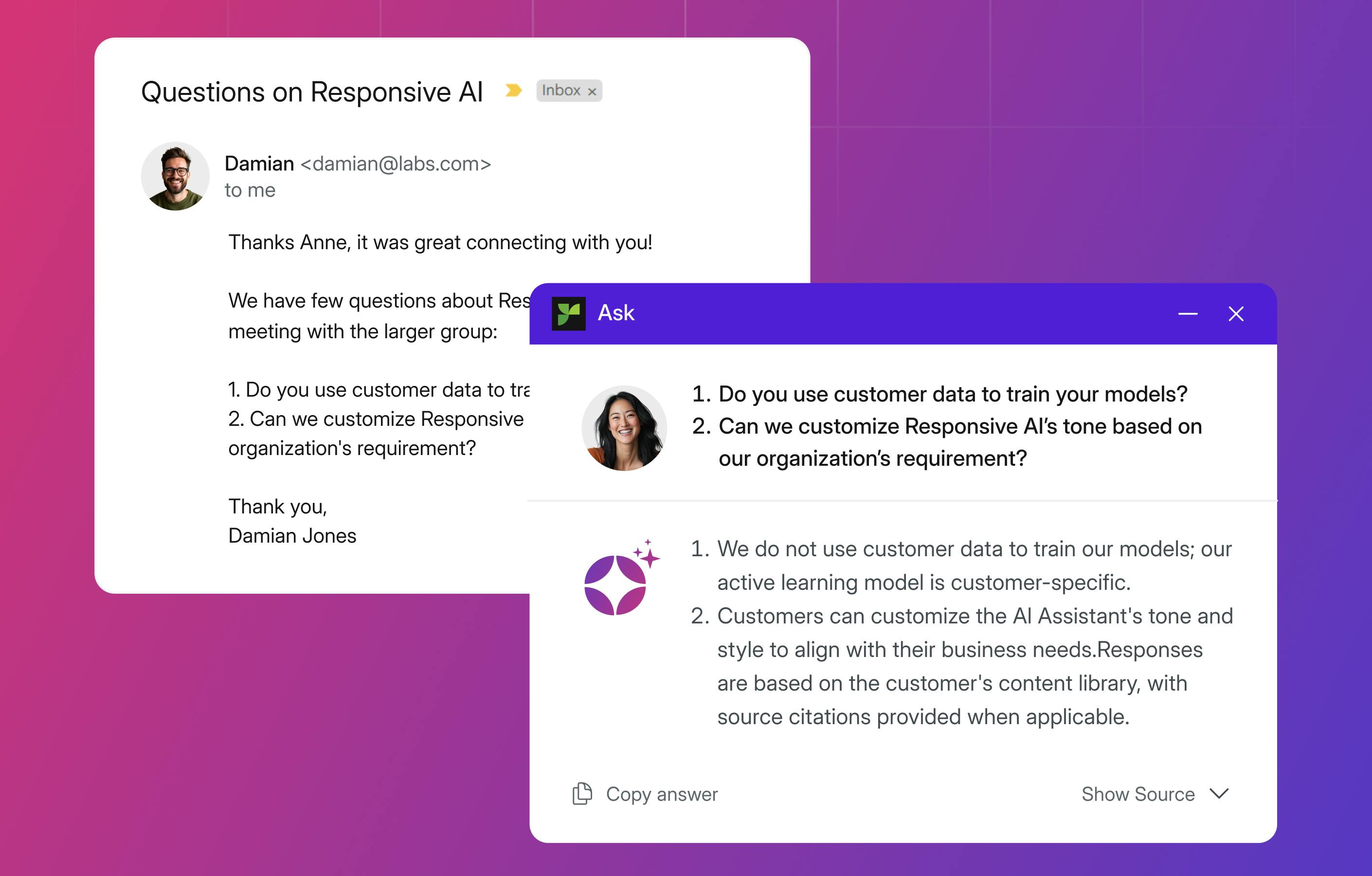
ECM is a strategic capability that drives speed, consistency, governance, and growth; it cannot be relegated to the sidelines of enterprise strategy. As shared in this guide, effective programs combine governance, integration, and adoption practices with AI-powered tools to keep content current, compliant, and accessible at scale.
The Responsive Platform brings these elements together. With Responsive, enterprises can:
- Centralize content in the Content Library for a single source of truth
- Enable conversational search with Ask, delivering cited, trusted answers in real time
- Extend knowledge into everyday tools with LookUp, reducing silos and accelerating collaboration
- Leverage advanced enterprise features such as Guided Projects, AI Agent Studio, and the option to connect your own LLM accounts.
- Accelerate rollout and adoption with Professional Services
By treating ECM as a driver of growth, enterprises unlock organizational knowledge, improve response quality, and strengthen their ability to compete. Responsive acts as a partner in Strategic Response Management, helping teams move beyond reactive content upkeep toward proactive, revenue-focused outcomes.
To see how ECM can support your organization, explore the Knowledge Management capability page or request pricing tailored to your needs. For tactical guidance on centralization, self-service, and analytics, visit our knowledge management best practices guide.
